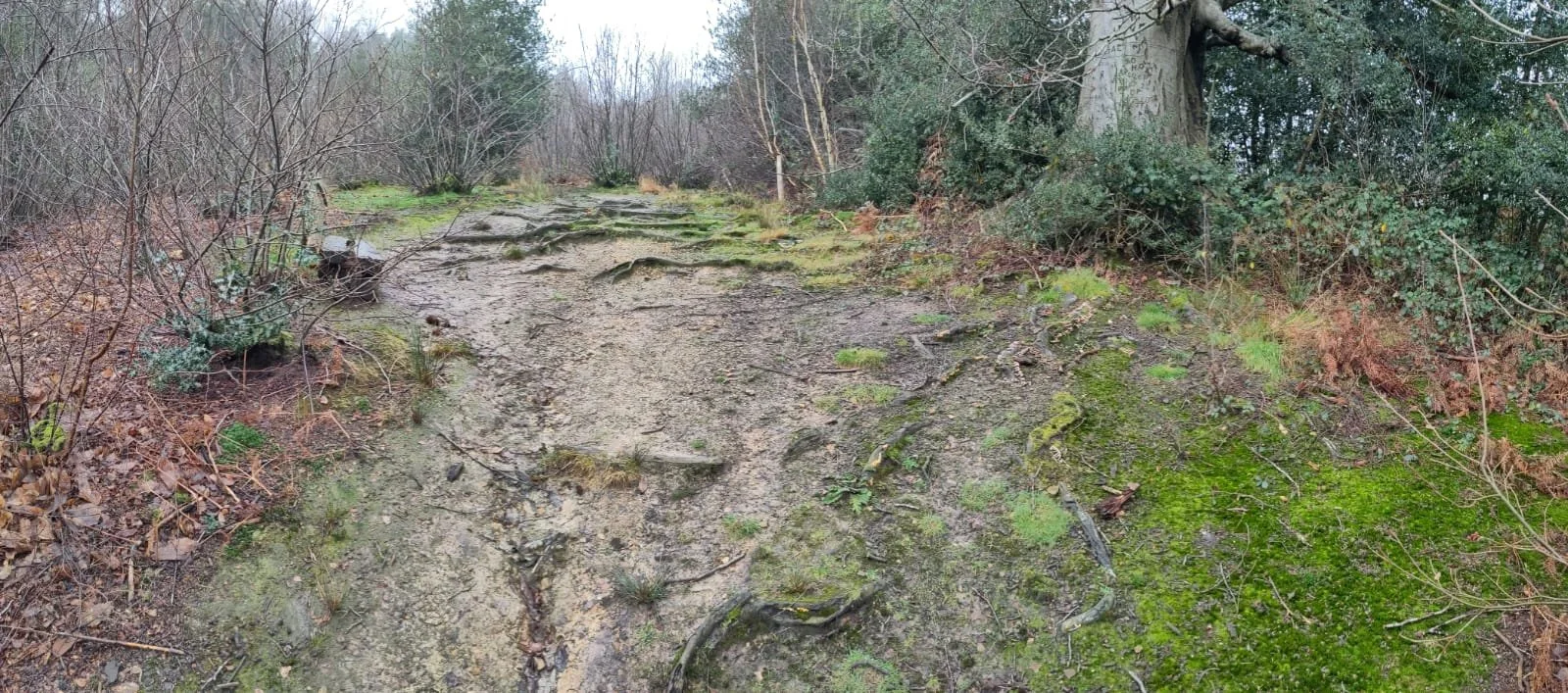Saving Big Beech
Big Beech resurrection plan. A move the A-Z path away from the tree’s roots, B. Build a ‘leaky dam’ across the steep slope to reduce run-off, C. dig a run-off ditch to a drainage ditch at C.
Deep in Wilderness Wood there sits a very big beech tree. It will come as no surprise that it has been awarded the name of Big Beech. It has probably stood here for anything from 200 to 400 years. I suspect at least 300. There is at least one other large beech of comparable size in the wood – Grandma Beech, but she is less obvious to visitors. Whilst Grandma hides amongst lots of lesser trees in a corner of the wood, Big Beech stands alone and proud next to the A-Z trail which guides visitors around the 62 acres of Wilderness Wood.
In its younger years Big Beech was probably a boundary tree on the edge of the wood, most likely planted to mark the point between the wood and the adjacent land owner’s fields. Trees, especially species like Beech and Oak whose increasing size enables them to become distinctive markers of the landscape, have long served the purpose of defining boundaries or places to gather. In my home town of Battle in 1066 Harold Godwinson, King of England, is believed to have gathered his troops on top of Calbeck Hill by the Hoar Apple Tree before his doomed attempt at repelling the Norman pretender to his throne, William Duke of Normandy – William the Conqueror.
Last summer I had a sabbatical for some months and on my return to the woods discovered that Big Beech had apparently died suddenly. It still had most of its leaves, but they were much smaller than usual and were turning yellow and brown. I say apparently died, but I think it more likely that it had decided upon a sabbatical break of its own, until the following growing season. Deciduous trees do this over the winter when there is insufficient light to support life processes, so why not during the hottest summer on record?
Path erosion due to trampling and surface runoff has removed soil and exposed roots
Whatever the cause we have decided that something must be done to attempt a resurrection. My suggested plan is:
Move the A-Z path which passes the tree to a line about 10 or 20 metres away from it. This should reduce the footfall on the ground above Big Beech's roots and stop further compaction of the soil. A compacted soil has less air and water spaces between soil particles and it may well be this that is killing the tree.
The high footfall also encourages soil erosion by killing any plants whose roots potentially stabilise the soil. Without these the increased winter run-off water just washes the soil away, exposing Big Beech’s tree roots as it does.
To counter this soil erosion we will put a form of leaky dam across the steep path down which winter runoff cascades. A large limb of Big Beech has fallen off, so it will make an ideal core for our proposed leaky dam. Other smaller branches, rocks, soil and biodegradable matter can also be added to our runoff barrier.
Many of the Wilderness Wood paths suffer from surface runoff, but we have countered this by digging run-off ditches to divert the water into the adjacent woodland. We will therefore do the same at Big Beech diverting it into an adjacent ditch to reduce run-off.
The adjacent ditch presents an excellent way of removing unwanted winter run-off, but in the summer we need to retain this water, so damming of the ditch should give us a store of water to irrigate the tree roots when the surrounding soil is dry. The ditch will still remove excess water but will enable us to retain a proportion of it for the tree to use.
We may be able to loosen the soil around the tree’s roots in some way to address the soil compaction issue, but I am concerned that in doing this we don't make matters worse for the roots.
If Big Beech continues to decline then we may need to reduce its crown to reduce evapotranspiration from any leaves it may produce. Oak trees (and I daresay beech too) will stag-horn and naturally lose limbs as they age in order to achieve the same end. In fact the large limb mentioned in 3. above may well be the result of the tree doing just that.
Should Big Beech eventually die then we will retain it as standing deadwood for the benefit of wood-boring invertebrates and their predators eg. woodpecker, tree creeper, nuthatch.
We hope to start to carry out this remedial work during our Stewardship Saturday session on 1st February, so anyone wanting to play their part is welcome to contribute.
Likewise, any knowledgeable arborists are invited to share suggestions by contacting me at davidwillhorne@googlemail.com.
David Horne
PS I’m off to the woods today to start on some of the remedial work outlined above. We had a good site meeting last week and agreed to save this iconic tree using volunteer labour and some of the ideas above. It may be a long shot but hopefully we can save Big Beech as a venerable and veteran tree. If not it will serve the biodiversity of the woods as it lives out its afterlife providing a rich habitat for fungi, plants and animals in Wilderness Wood


